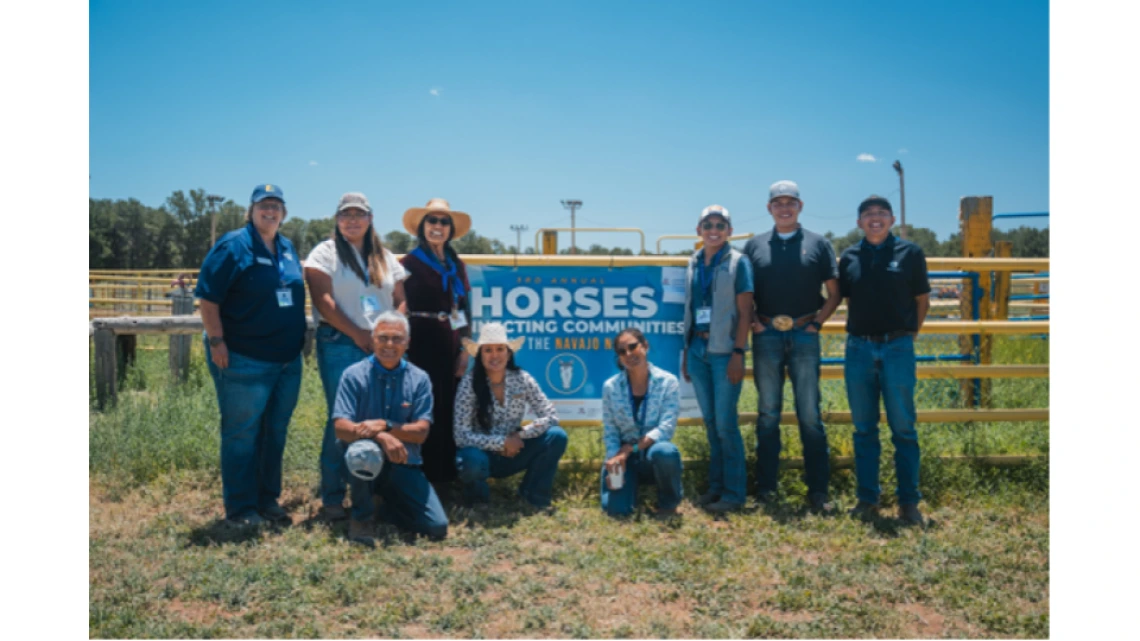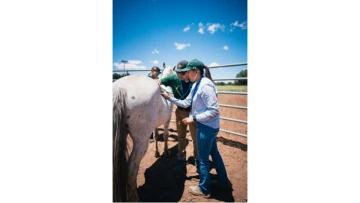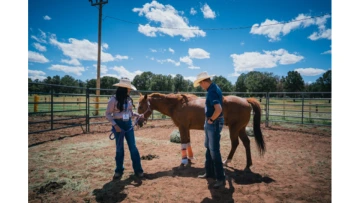Horses Connecting Communities Annual Meeting

Going Left to Right Back Row: Dr. Betsy Greene, Kaitlyn Benally, Dr. Alberta Arviso, Brendan Walker, Brennen Jones, Donovan David
Going Left to Right Front Row: Dr. Gilbert John, Santana Nez, Dr. Kelsey Dayle John
Photo Credit: Wade Adakai
The Horses Connecting Communities Across Navajo Nation meeting began in 2018 and was started as a part of the Navajo Nation’s requirement to make my dissertation research relevant for the Navajo community. Following the practice of meaningful Indigenous research, the Navajo Nation Human Research Review Board (NNHRRB) requires that research approved by the board have a direct community impact. As a Diné horse woman, I was eager to explore horse knowledge with my community and make connections about how horses and humans learn together.
Even when my dissertation research ended, it was important for my relationship with my community to be ongoing and for my work to continue to be relevant. Indigenous scholars and communities have argued that researchers often arrive, do research, and leave communities once their research is finished without ever sharing findings or creating solutions based on the data. The Horses Connecting Communities meeting is a way to keep what I learned in my research active and to create continued learning spaces in the community. This year’s meeting is the product of seven years of engagement and work which started with my initial desire to learn Navajo language and connect with people. During this time, I started to ask if people were interested in horses and if they thought horse-focused research would be a good idea, overwhelmingly there was support. From there, I took one year to navigate the Navajo Nation Human Research Review Board and I started my research in 2017; my full dissertation was approved at the chapter, agency, and nation level in 2019.
From the research, I learned there was a desire in the community to connect through traditional horse knowledge, horse care, and resources for young people–especially students interested in pursuing equine related careers. I also learned that Diné folks were braiding together Diné knowledge and Western science about horses in sophisticated ways. After positive feedback from the community regarding the 2018 meeting, I continued the work when I started as a faculty member at the University of Arizona. It is important to note that many Navajo people (including our presenters) are already doing this work in the community. My goal was not to reinvent or take credit for this learning process, but to create a meeting place for Diné horse lovers to connect and learn from one another.
This conference is organized using Indigenous knowledge transmission which centers Diné experts and knowledge holders as well as oral and hands-on learning. Oftentimes, our Diné knowledge systems are not considered relevant or valid within Western scientific communities, rather they are considered “cultural or religious knowledge.” Additionally, Diné people have not been the primary authors of their own histories and education especially regarding animal husbandry and agriculture. Because of this, addressing challenges within the Diné community requires a unique and transdisciplinary approach. Because there are specific cultural and traditional beliefs about horses as well as challenges wrought through decades of colonial intervention, solutions used in the non-Native context and Western worldview are untenable. Our cultural knowledge has always existed in conversation with scientific knowledge. This conference aims to address this division inside and outside of the community through a carefully curated list of experts and topics. Namely, these experts are Diné community members who are braiding together Diné and Western science. It is important for the community to hear from experts who are members of the tribe because of an ongoing legacy of outsider experts intervening within Diné community spaces and causing damage to our knowledge systems.
Honoring the horse aligns with the traditional Diné belief system which regards the horse as sacred. Recognizing the sacredness in the present day, requires a balance of cultural and scientific knowledge. HCC highlights traditional elders/experts, tribal members who are veterinary students, community educators through the Tribal Extension program, and scholars who work on community projects that address human/animal/land wellness through a Diné epistemology. This year featured first aid and equine physical exams with five Diné Veterinary students: Brendan Walker, Brennen Jones, Kaitlyn Benally, Donovan David, Satanan Nez, and UA Extension Horse Specialist Dr. Betsy Greene. Other presentations included farrier and hot shoeing with Master Farrier Wayne Franklin & Extension Specialist Leander Thomas, riding with AQHA & NRHA member Ty Jones, training with Triple “B” Ranch owner Boyd Brodie, biosecurity infectious disease specialist Dr. Gilbert H. John, Dr. Betsy Greene, Breanna Salt, and Donovan David, stories with expert horseman Gene Shepherd, vaccines with Dr. Gilbert H. John & Dr. Betsy Greene, confirmation from equine trainer and horsemanship coach Audre Etsitty, Equine Facilitated Learning with education expert Dr. Herman Cody & Dr. Kelsey John, safe trailer hauling practices with horse woman Morgan Farrell & extension specialist Grey Farrell, with operational support from UA CVM’s Senior engagement officer Dr. Alberta Arviso & undergraduate Veterinary Science student Alani Rhodes. Thank you to our presenters and planning committee who made this year’s meeting a success and for doing such amazing work in your community. With the help of all these experts, it is my hope that HCC will continue to grow and connect horse lovers across the Navajo Nation.
Thank you to this year’s partners and sponsors: Diné College Land Grant Office, UA College of Veterinary Medicine, Navajo Agricultural Products Industry, Agnes Nelms Haury Program in Environment and Social Justice, University of Arizona College of Social and Behavioral Sciences, Indigenous Resilience Center, UA Cooperative Extension, UA Provost’s Investment Funds, Colorado State University College of Veterinary Medicine and Biomedical Sciences.

Donovan David (Back) is a third year veterinary student at Colorado State University demonstrating to an attendee how to check for vitals. Photo Credit: Wade Adakai

Santana Nez (left) a third year vet student and Brennen Jones (Right), a second year vet student, both attending the University of Arizona College of Veterinary Medicine demonstrating how to properly bandage a leg wound. Photo Credit: Wade Adakai
